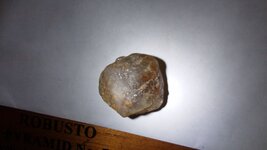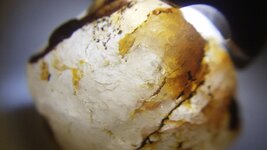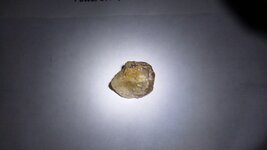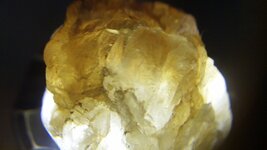BurntBear
Bronze Member
- Jul 4, 2014
- 1,450
- 1,299
- Detector(s) used
- Shovels....lots of shovels!
- Primary Interest:
- Other
I've struggled a bit with this, but I think I'm catching on; we'll find out, lol.
Although Citrine is a color-variety of Quartz, there always seems to be controversy & speculation as to "what" is "what" and what is real.
I've researched and the only real difference that I can see is how the trace minerals (aluminum, iron oxides, etc.) are placed in, or on the crystal.
So, if the foreign minerals are inclusions; it is technically stained Quartz and if they are actually part of the crystal structure, it would be Citrine.
I took this photo today of one of my specimens of Smoky Quartz with a yellow appearance to it:

Under magnification, you can clearly see that the yellow is from inclusions of foreign minerals:

I tried another specimen:

Under magnification, this one turned out different. The crystal itself is yellow and although there are a few spots that are inclusions; I believe these trace minerals are part of the crystal structure.

Any input and help would be appreciated!
Although Citrine is a color-variety of Quartz, there always seems to be controversy & speculation as to "what" is "what" and what is real.
I've researched and the only real difference that I can see is how the trace minerals (aluminum, iron oxides, etc.) are placed in, or on the crystal.
So, if the foreign minerals are inclusions; it is technically stained Quartz and if they are actually part of the crystal structure, it would be Citrine.
I took this photo today of one of my specimens of Smoky Quartz with a yellow appearance to it:

Under magnification, you can clearly see that the yellow is from inclusions of foreign minerals:

I tried another specimen:

Under magnification, this one turned out different. The crystal itself is yellow and although there are a few spots that are inclusions; I believe these trace minerals are part of the crystal structure.

Any input and help would be appreciated!
Last edited:



